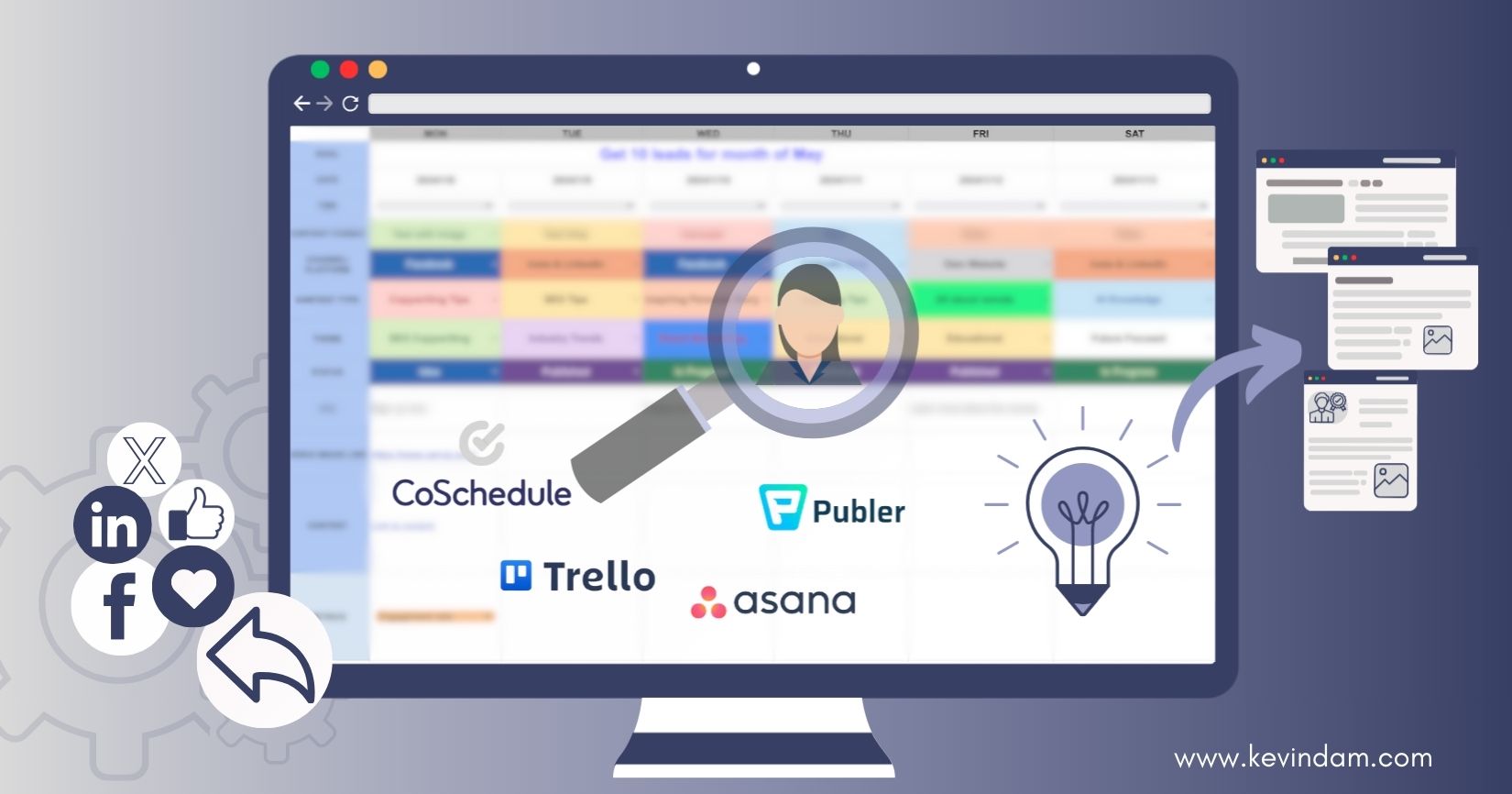
Last Updated July 22, 2024
The Ultimate Content Plan Guide 2024 for Effective Marketing Strategies
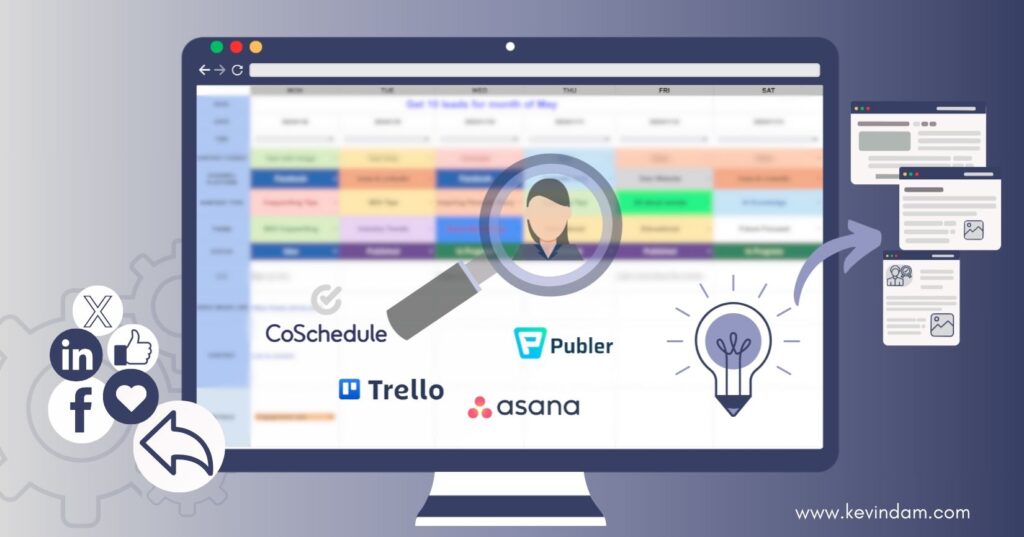
A comprehensive content plan is essential for achieving effective marketing results in 2024 and beyond, focusing on the elements that both search engines and your target audience crave. In this article, you’ll learn essential techniques to understand your audience, set SMART goals that drive real business results and expand your creative horizon in brainstorming killer content across various formats.
You’ll also master the art of content scheduling with a dynamic editorial calendar, learn to leverage different platforms to amplify your reach and understand techniques for monitoring and iterating your content plan based on data-driven insights, continuously optimising your strategy for better results.
Why Develop a Content Plan?
- Clarity and alignment: A content plan compels you to define goals, identify your target audience, and select topics that align with achieving these goals.
- Consistent Content Flow: Planning ensures a steady stream of content across your channels, keeping your audience engaged and informed with new information and interesting content
- SEO Optimization: Crafting a content plan that incorporates relevant keywords can significantly boost your website’s SEO. This drives organic traffic, expands your reach, and establishes a strong online presence that sets you apart from the competition.
- Establishing brand identity: A tailored content plan empowers you to cultivate a unique brand voice that connects with your target audience on a deeper level, fostering brand loyalty.
- Performance Measurement: With a content plan, you can track valuable metrics that shape future strategies. This empowers you to adapt and refine your content creation process more effectively.
- Building Trust: Consistently creating high-quality content that resonates with your audience builds trust and establishes credibility. This translates to stronger customer retention and loyalty.
- Audience Growth: By planning ahead, you can develop a comprehensive content plan that appeals to various audience segments, maximising engagement and driving overall growth.
Structuring Your Content Plan
When it comes to creating a successful content plan, organisation is key. Let’s look into the essential component that should be defined and put in place to ensure that your content plan is effective:
Setting Clear Goals and Aligning Objectives
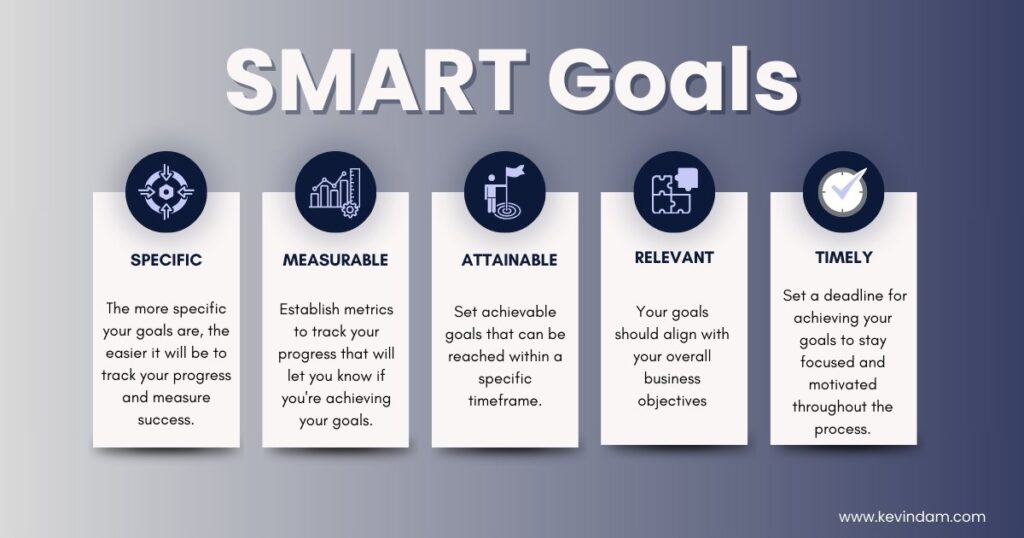
Determining specific, measurable goals is crucial to aligning your content with your overall business objectives.
Business objectives form the backbone of any content strategy. The chosen content themes should reflect and further the business’s aims. For instance, if the goal is to position your brand as a thought leader in the industry, focus on topics that are educational and insightful. This way, your audience perceives you as a valuable source of knowledge in the field.
To be truly effective, your goals should be SMART:
- Specific: Clearly define what you want to achieve. Instead of “increase brand awareness”, aim to “increase website traffic by 15% within 3 months”
- Measurable: Establish metrics to track your progress. How will you know if you’ve achieved your goal?
- Attainable: Set goals that are ambitious but achievable with the resources you have.
- Relevant: Ensure your goals align with your overall business objectives and target audience needs.
- Time-Bound: Set a timeframe for achieving your goals to create a sense of urgency and focus.
If your goal is to increase brand awareness, your objectives might be:
- Publish two blog posts per week on relevant industry topics.
- Increase social media engagement by 20%.
- Partner with influencers in your niche.
Setting clear goals and defining your objectives ensures consistency in messaging and values across all platforms, helping build a strong brand identity. This provides a clear benchmark for your content team to work towards, ensuring that everyone is on the same page in terms of what needs to be achieved.
Know your audience
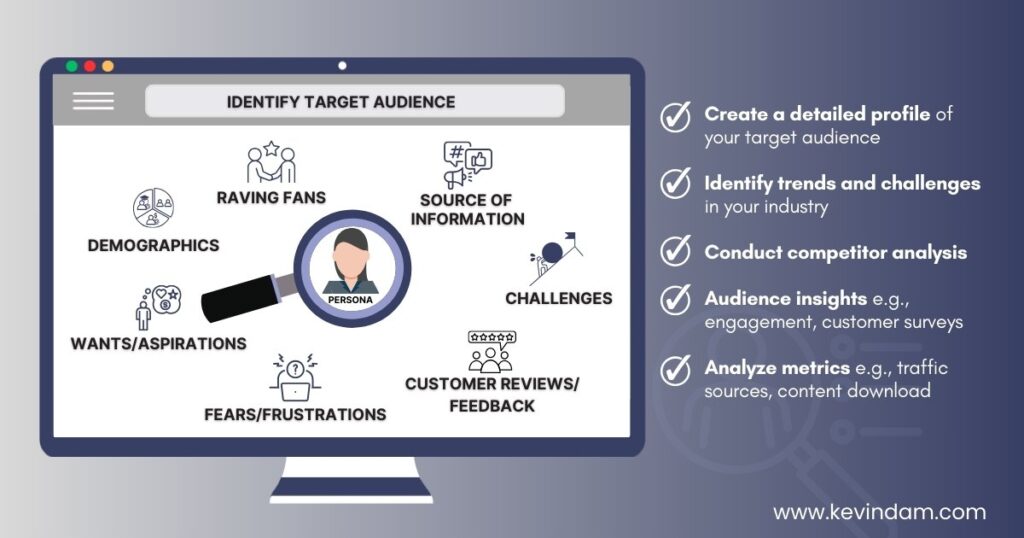
A successful content plan hinges on a deep understanding of the people you’re trying to reach. So, how do you get into your audience’s insights? Here are some practical steps to get you started:
- Create detailed profiles of your ideal customers – fictional characters that embody your target audience’s characteristics, goals, and challenges.
- Determine their demographics. Age, location, income level, education, etc.
- What are their pain points?
- What are their interests and needs?
- Where do they spend their time?
- What type of content do they consume?
- What motivates them? What kind of tone and style resonates with them?
This tailored approach creates a direct connection between your brand and its consumers, making them feel understood and valued.
- Industry Trends: Identify current trends and challenges within your industry. What are people talking about? What problems are they facing?
- Competitor Analysis: See how your competitors are addressing these issues through their content. What content formats do they use? What are their strengths and weaknesses?
- Audience Insights: Leverage available data on your target audience. Look at website analytics, social media demographics, and customer surveys.
- Website analytics. Analyse metrics like traffic sources, time spent on specific pages, and content downloads to understand what kind of content resonates most with your audience
Establishing Content Categories
An effective content plan should cater to various audience needs by offering a diversified mix of content. Organising content themes into distinct categories based on relevance can help achieve this. Categories such as educational, entertaining, or promotional content can ensure that your audience’s diverse interests are addressed.
Educational content can help build thought leadership and provide value to your audience, while entertaining content can engage and retain their interest. On the other hand, promotional content can drive direct action from your audience, such as signing up for a newsletter or making a purchase.
Brainstorming topic ideas:
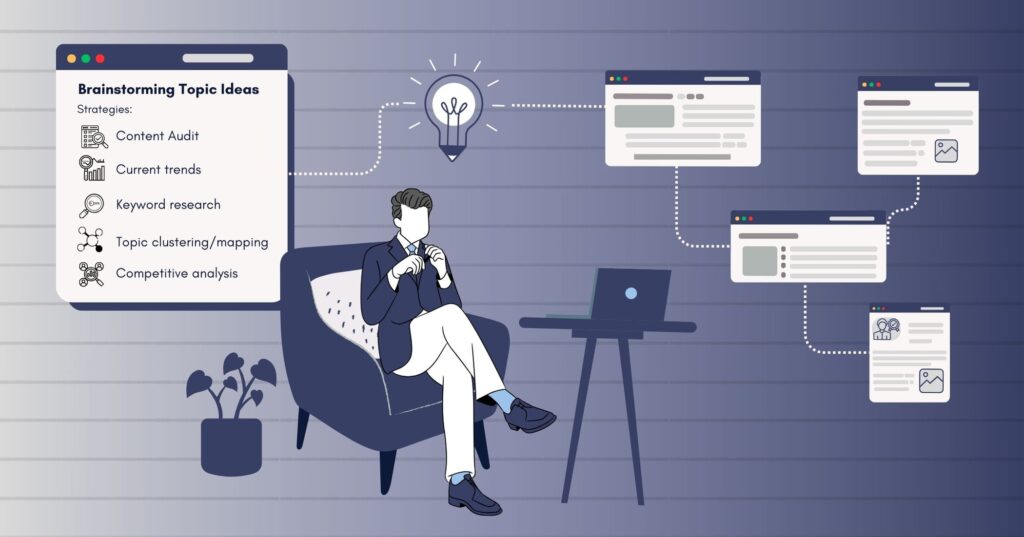
This step involves synthesising the insights garnered from your research to generate content themes that are both engaging and relevant. It should address the specific questions, problems, and interests identified within your target audience.
Here are some strategies to get those creative juices flowing:
- Content Audit: Before creating new content, check what you already have. Identify high-performing pieces you can leverage and areas where content gaps exist by evaluating your existing content.
- Keyword Research: Identify the search terms and relevant keywords with the use of keyword research tools. Incorporating these keywords organically into your content increases your chances of ranking higher in SERPs, driving more organic traffic to your content.
- Current trends: Stay informed of current events and industry trends. Can you create content that offers a unique perspective on a trending topic? By capitalising on timely themes, you can generate fresh and relevant content for your audience.
- Ideation Techniques: Brainstorming techniques like mind mapping or topic clusters can be done by your team to generate fresh ideas. Mind mapping allows you to visually connect ideas and spark new content possibilities. Topic clusters involve grouping related content around a central theme, ensuring a cohesive and informative user experience.
- Competitor Analysis: While you don’t want to simply copy your competitors, there are valuable insights from their content strategy. Analyse what kind of content your competitors are creating, what topics they’re covering, and how their audience is responding. Use these insights to identify gaps in their strategy and develop content that stands out from the crowd.
Creating a Content Calendar
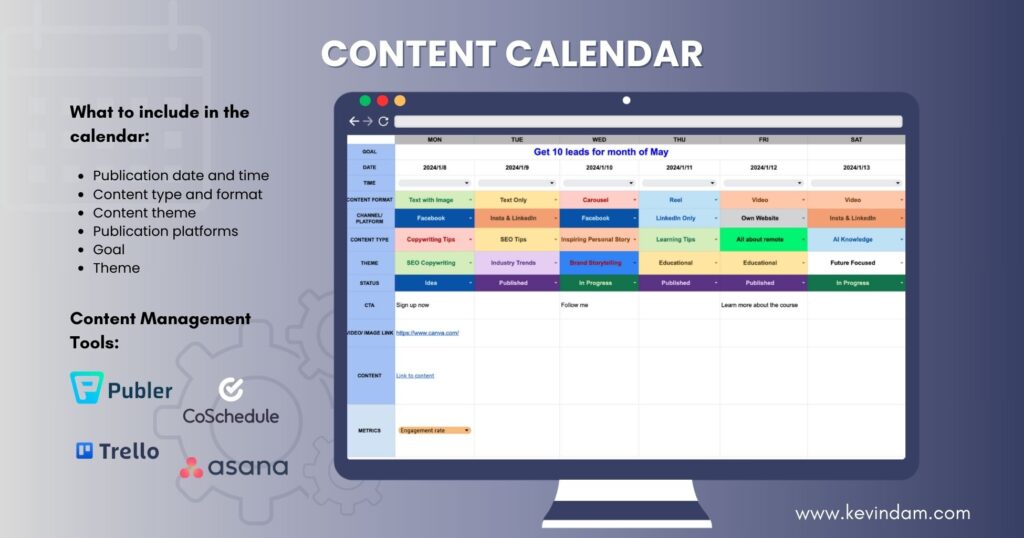
This calendar is your roadmap to content marketing success. Here’s how to leverage it effectively:
- Choose Your Platform: There are numerous content calendar tools available, ranging from simple spreadsheets to dedicated content management software. Select a platform that suits your workflow and team size.
- Schedule Your Content: Plot out your content across various platforms (website, social media, email marketing) for a specific timeframe. Aim for a consistent publishing schedule to keep your audience engaged and coming back for more.
- Content Diversity is Key: Don’t get stuck in a content rut. Plan a mix of content formats like blog posts, infographics, videos, and social media content, catering to different audience preferences and learning styles.
- Assign Roles and Responsibilities: For larger teams, designate clear roles and responsibilities for content creation, editing, and publishing. A well-defined workflow ensures a smooth content production process.
- Integrate with Promotion Strategy: Your content calendar shouldn’t exist in isolation. Use it to plan your content promotion strategy alongside content creation. Schedule social media posts, email blasts, and other promotional activities to amplify your content’s reach.
Once you’ve gathered your ideas, topics, and categories, you need a plan to make everything fit together seamlessly. A content calendar helps visualise your entire content plan at once. The calendar should outline the publication schedule, including:
- key date
- content type and format
- content theme
- publication platforms
Tools like Trello, Asana, or CoSchedule can be used for effective calendar management so you can streamline the process and have everyone informed about their responsibilities and deadlines.
The editorial calendar serves as a roadmap for your content creation efforts, ensuring that you maintain consistency in publishing and stay ahead of upcoming events or campaigns. It also allows for better coordination among team members and helps avoid any last-minute rushes or oversights in the publication process.
By carefully structuring your content plan outline with clear goals, diverse content categories, and an organised editorial calendar, you are setting the stage for a well-executed and impactful content strategy. Each component can guide your team towards achieving your marketing goals and engaging your audience effectively.
Creating engaging content on different platforms
To maximise the value of your online content, consider starting with long-form content like detailed blog posts—a goldmine for generating short-form content tailored to diverse social media platforms. The key lies in extracting the most compelling elements and repackaging them to suit the unique characteristics and audience preferences of each platform.
Key statistics or insightful quotes from a long-form article can be transformed into eye-catching graphics for Instagram or Pinterest, making complex information digestible and shareable. Twitter, with its concise text limit, is ideal for sharing standout facts or questions that spark curiosity and encourage clicks back to the full article.
LinkedIn, a platform for professional networking, offers an opportunity to share more in-depth summaries or thought leadership insights derived from longer content, appealing to industry professionals seeking to broaden their knowledge.
Meanwhile, short clips or teasers from longer video content can captivate audiences on TikTok or Instagram Reels, offering a glimpse into the wider discussion or story that can drive viewers to seek out the full content.
This approach not only broadens the reach of the original long-form content but also caters to the diverse content consumption preferences of social media users, enhancing engagement across channels.Promoting your campaign

A strong promotion strategy ensures that your hard work reaches your target audience and delivers the results you’re looking for. Here are some key strategies:
- Identify the right channel and platform nuances: Consider where your audience spends their time online. Is it on social media platforms like Instagram or Twitter? Industry-specific forums? By mastering layout design and aligning it with an effective release schedule based on data-driven insights, we can ensure that our content not only looks great but also reaches our audience at the right time for maximum impact.
- Consider timezone differences: I’m sure you’ve noticed that certain times of day seem to work better for getting engagement from your audience than others. Analysing data around this can help determine the optimal release times based on audience behaviour and engagement patterns across different time zones. Understanding when your audience is most active can significantly boost your content’s performance.
- Organic promotion: Utilize the features of each platform to organically spread your content. Share content on social media, optimise for search engines and encourage organic sharing through calls to action
- Paid promotion: Paid advertising on social media or search engines can give your content an extra boost. Paid options allow you to target specific demographics and interests, ensuring your content reaches the right people.
Performance tracking and Iteration
As the saying goes, “What gets measured gets managed.” This is especially true in the world of content marketing. Once your content is out there, you need to track how it’s performing. This helps you understand what resonates with your audience and identify areas for improvement.
For instance, we notice that a certain blog post consistently attracts high levels of engagement and leads to increased conversions, it indicates that our audience finds that particular topic valuable. On the other hand, a high bounce rate on a specific landing page signals that we need to reassess the content on that page to better capture and retain visitors’ interest.
Here’s how to monitor your content:
- Define KPIs (Key Performance Indicators): Set specific goals for your content. These could be website traffic, social media engagement, leads generated, or sales conversions. Choose KPIs that align with your overall marketing goals.
- Analytics tools: Utilising powerful analytics tools like Google Analytics, SEMrush, or Moz can provide valuable insights into the performance of your content. These tools allow us to track audience behaviour, measure the impact of our content plan on business objectives, and gain a deep understanding of our audience’s preferences and habits.
- Analyse and adapt: Regularly review your analytics data. See what content performs well and what doesn’t. Use this information to adjust your strategy, optimise content for better performance, and identify new content ideas that resonate with your audience.
Analytical insights empower us to understand the effectiveness of our content plan in achieving business goals. It allows us to adapt swiftly to changes in audience preferences, search engine algorithms, and market trends while continuously enhancing the value we deliver to our audience.
Are we reaching the right audience? Are our efforts translating into meaningful results, such as increased brand awareness or higher conversion rates? Maximising the potential of our content plan involves a continuous cycle of analysing content metrics, identifying successful strategies, and refining underperforming elements to enhance overall effectiveness.
Conclusion
A well-executed content plan is a roadmap ensuring a steady flow of valuable, engaging content across multiple platforms. It empowers businesses to establish a strong brand identity, improve search engine visibility, drive website traffic, and, ultimately, generate more leads and conversions.
By following the steps outlined in this guide, businesses can craft a content strategy that truly resonates with their target audience. A content plan should also be regularly reviewed and updated to adapt to evolving market trends, audience preferences, and business objectives. Embracing a data-driven, iterative approach to content planning will enable businesses to continuously refine their strategies, optimise their efforts, and stay relevant and ahead of the curve.
